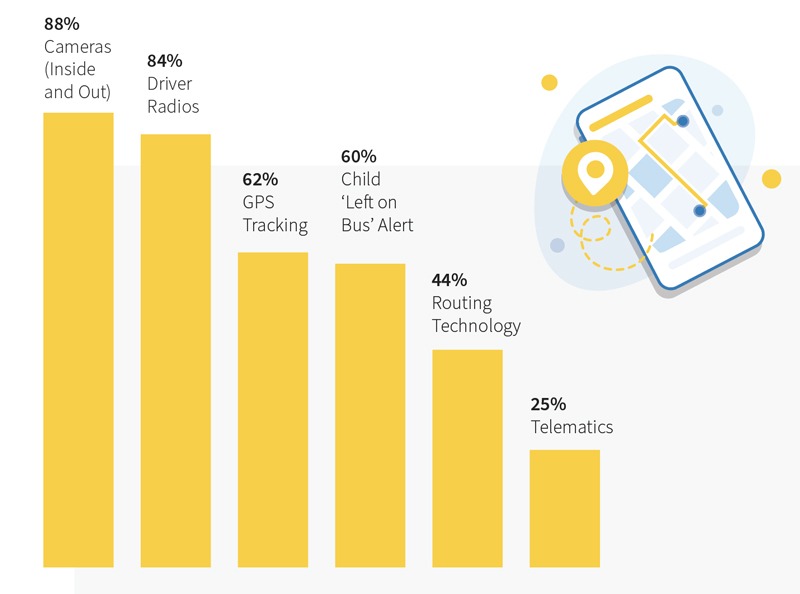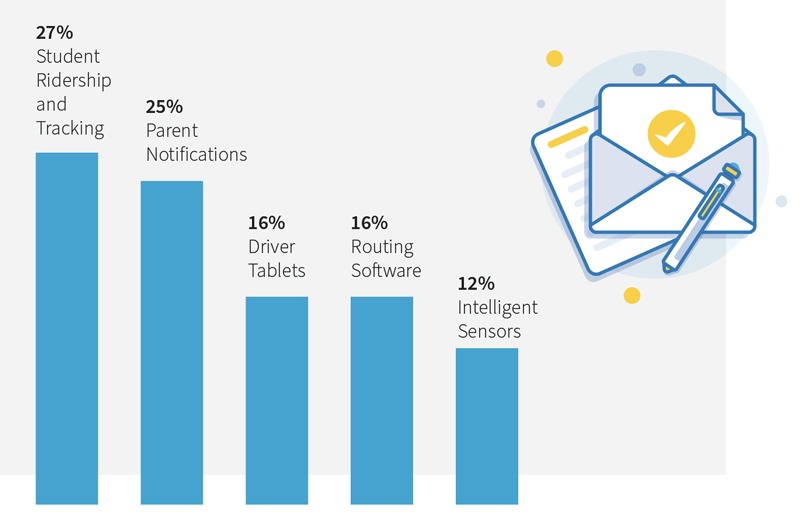School Transportation News polled over 500 transportation leaders in May 2020 and found that 13% of respondents already have WiFi installed on some or all buses.
In a survey with 300 K-12 transportation leaders, 19% of respondents stated that they were interested in adding student WiFi to their fleet in the 2020-21 school year. With this increased interest among K12 transportation departments across the country, let’s dive into how school bus WiFi benefits students, drivers, educators, and transportation leaders.

Support Students’ Academic Success
Extend the Classroom to the Bus

Students spend an average of 40 minutes per day on their daily routes. That adds up to 180 hours every school year. Students who participate in extracurricular activities, such as athletics and clubs, spend even more time on the school bus traveling to and from events.
When buses are equipped with WiFi, this time can be spent completing homework.
For students without Internet at home, or for those with other responsibilities after school, such as caring for siblings or working a job, this time spent on the bus may be the only time they have to complete their online assignments.
“Clearly, when we give kids the ability to take home a Chromebook, we have them learn at home. And now the same is true on your way home. our kids are so busy, travel home and then jump in a car to little league practice. Now you can do homework on the 45-minute bus ride.” – Dan Mannix, Superintendent, Beekmantown Central School District
Connecting Students Amid School Closures
Schools may close for many reasons, such as snow days, hurricanes, and as we saw in 2020, a health crisis. When schools are forced to close and shift to online instruction, students without Internet at home will find it difficult to participate in virtual learning and complete online assignments.
Districts can easily turn their WiFi-equipped buses into community hotspots to help provide access for students. The buses can be parked in neighborhoods, apartment complexes, mobile home parks, and school or church parking lots.

Student and Driver Safety
Raytown School District launched a WiFi pilot program on six of its buses. After installing WiFi, the number of disciplinary referrals across the pilot buses dropped from 105 to 58—a 45 percent decrease overall.
Another district, Aurora Public Schools, saw a 75% decrease in reported disciplinary issues from the 2017-18 school year to the 2018-19 school year once they installed WiFi on their buses.
“I was not surprised to see that when kids are busy and have something to work on, they’ll stay out of trouble. I was shocked at the anecdotal and data reports of how much better it was, though. I wasn’t expecting those kinds of numbers.” Kevin Easley, Director of Transportation, Raytown School District (MO)
When students are seated and engaged while on the bus, it creates a safer experience for both drivers and students.
Connect Your Bus Technologies
The number of devices and software solutions used in K12 transportation increases every year. According to a survey of 300 K-12 transportation leaders here are the technologies currently deployed on their buses:

Here are technologies these same transportation leaders have on their wish list for the 2020-21 school year:

WiFi on the bus can be used for more than just connecting students. It can be used to connect any bus tech that requires an Internet, such as driver tablets, GPS, telematics, and cameras.
Getting Started
Here are some things to consider before adding WiFi to your fleet.
- Web Filters– How will your school bus WiFi solution is filtered to meet CIPA guidelines and to keep student safe and on-task?
- Kajeet SmartBus™ includes customizable CIPA-compliant filters designed for K-12.
- LTE Network– Which wireless network will you choose to connect your devices?
- Kajeet connects on all major North American wireless networks – choose the network(s) that work best in your area.
- Device and Data Management– How will you manage device usage and data consumption across your fleet?
- Kajeet SmartBus™ includes access to a patented device and data management portal, Sentinel® where administrators can manage devices, data allocations, filters, and access controls.

